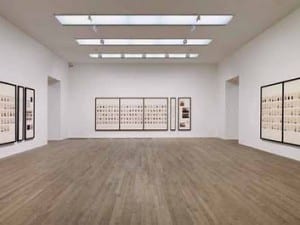The David Robert’s Art Foundation opens its new doors at Mornington Crescent with House of Leaves. Aesthetica takes a moment to review the opening exhibition.
The small entry space of the David Roberts Art Foundation contains the obligatory gallery desk, complete with smiling interns. Backs to the wall, the interns face out toward the linear expanse of white galleries that make up the foundation’s new property.
Central in the small room is a levitating metallic form; a narrow, draped fabric that seems, somehow, to have solidified. It has a spectral tint, produced by a thin layer of white emulsion coating a bronze cast. The work is Louise Bourgeois’ Echo VIII (2007), and on closer inspection appears to be a sweater hung and stretched from sleeve to sleeve. Redolent of something familiar, its form remains defiantly evasive of category. This is the piece around which the exhibition is built.
On the wall to the left of the sculpture is a text by Bethan Huws (And I Sleep, 2002). The words speak of a dormant but stifling destructive urge confined within sleep. The letters are spaced out on a prefab message board. White letters in black slots, locked behind glass. Reminiscent of a church service board or trendy coffee shop menu, Huws supplies a message of something beneath the unassuming surface, but there is always the sense that the letters could be changed by tomorrow.
Also in the room is a small painting by Miriam Cahn (Überlebende 1998). The pinky edges of the canvas ruffle out against the wall. The image is of a woman, her eye piercing blue and pupil-less, her cheek, grey-green, her chest a startling bright pink, and her lips flecked with red. Side-on to the canvas, and painted in soft focus, her edges become indistinct from the grey backdrop. The three works in the room present a vision of the familiar, each bearing a formative distortion.
Matthew Day Jackson’s painstaking model of post-apocalyptic London (August 6, 1945, 2012), buildings burnt tit-bits of wood, and the Thames, a swathe of smoky lead snaking between, hangs on the wall looking out across Phyllida Barlow’s Untitled: Disaster 5 (2010). On the floor, a pink, red, and mouldy green, squashed spherical accumulation of junk materials. Whilst these two works speak of deterioration of the everyday in an adverse sense, John Latham’s Gone Fishing (1959), an accumulation of books, springs, and wires, floating upon a rumpled silvery canvas, becomes a jibe. Far from ominous, his dishevelled objects appear to be fished from the bottom of a river.
Ida Applebroog’s Trinity Towers (1982) is a pair of large-scale, red ink, line drawings, depicting on the left, two young nude males seated on a bed, and on the right, a similar male hung by his neck. The positioning of the images causes query over whether the diptych represents space or time in its two frames. Are the two boys on the left calmly watching this boy hang, or is this one of them later on? The red of the ink bleeds across the vellum surface, and the sense is that of the spectator being thrust through the image’s low-hanging blinds to see something private yet unnervingly familiar.
Man Ray’s Le Gant Perdu (1967-1968), a leather glove, double framed and outlined with string on a cheap wood backboard, seems to recapitulate and correlate all of the myths of the surrealists in one gesture. The glove, in the doorway, beckons the spectator into the farthest room of the exhibition. Here, there is another work of Phyllida Barlow’s, a great tangle of oversized cables made from electrical tape and hung from a large steel bracket (Rig: Untitled: Coils, 2011). The oranges and yellows of Barlow’s cables are echoed by Wilhelm Sasnal’s Untitled (Humintäre Hilfe) (2011). The humanitarian aid truck of the title provides the painting’s only foreground. Though the ostensible motion of the truck causes the words on its trailer to blur, the meticulously outlined, unspoiled white side of the vehicle is resoundingly stationary. The sky behind is a cracked and dripped pale blue with swathes of dirty orange pulled horizontally across it. The road is a wash of grey.
The works here all speak of a feeling of redolence. An implication of familiarity, but warped. In the case of Bourgeois’ work, the immediate distortion is a material transformation, not dissimilar to that induced by Wilhelm Sasnal. In the course of his translation of photograph into paint, he retains an implicit photographic quality within the overtly painterly image. However, a more absolute break with familiarity is presented in the form of time. Day Jackson’s burnt-out image of London seems a resigned vision of impermanence, and Bourgeois’ work looks, unexpectedly, to be a body collapsed. The hung form of the sweater, a flaccid reminder of a terminal transience.
House of Leaves, 21 September until 10 November, David Roberts Art Foundation, Symes Mews, London, NW1 7JE
Credits
1. Bruce McLean, Pose Work for Plinths, 1971, Courtesy the artist and David Roberts Collection, London.





